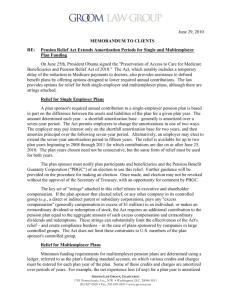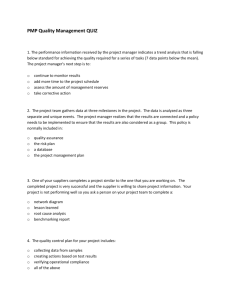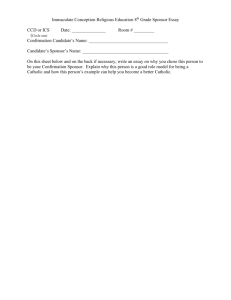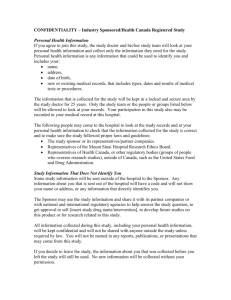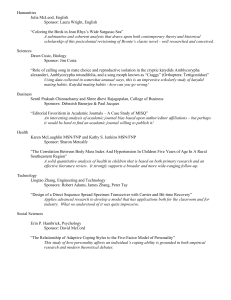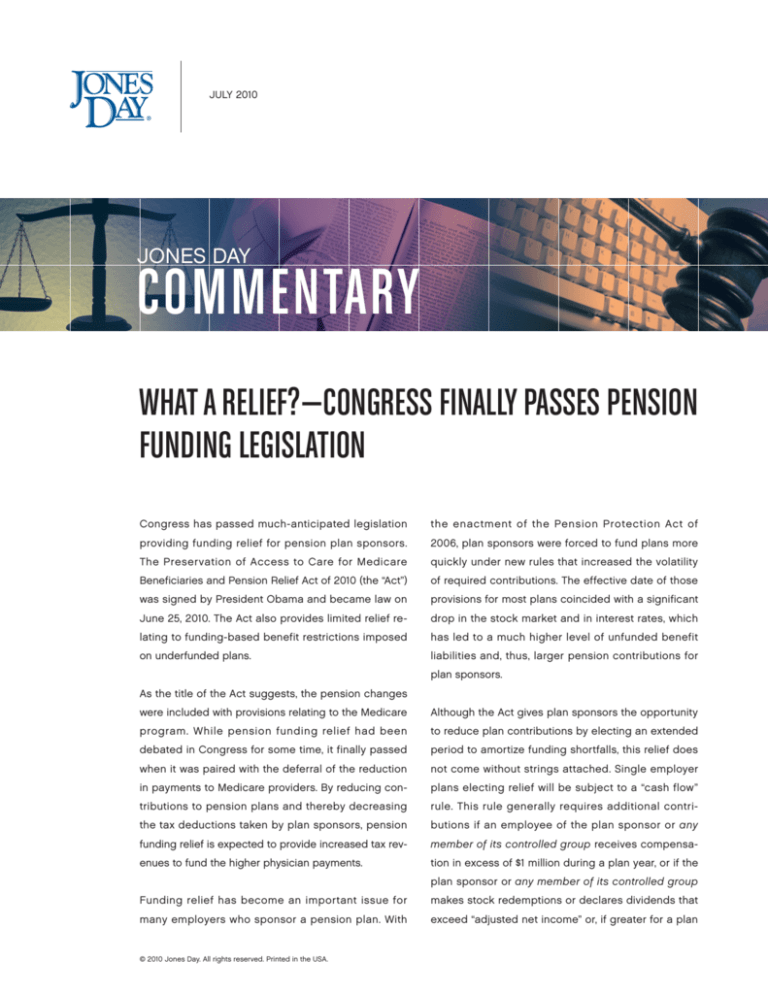
JULY 2010
JONES DAY
COMMENTARY
WHAT A RELIEF?—CONGRESS FINALLY PASSES PENSION
FUNDING LEGISLATION
Congress has passed much-anticipated legislation
the enactment of the Pension Protection Act of
providing funding relief for pension plan sponsors.
2006, plan sponsors were forced to fund plans more
The Preservation of Access to Care for Medicare
quickly under new rules that increased the volatility
Beneficiaries and Pension Relief Act of 2010 (the “Act”)
of required contributions. The effective date of those
was signed by President Obama and became law on
provisions for most plans coincided with a significant
June 25, 2010. The Act also provides limited relief re-
drop in the stock market and in interest rates, which
lating to funding-based benefit restrictions imposed
has led to a much higher level of unfunded benefit
on underfunded plans.
­liabilities and, thus, larger pension contributions for
plan sponsors.
As the title of the Act suggests, the pension changes
were included with provisions relating to the Medicare
Although the Act gives plan sponsors the opportunity
program. While pension funding relief had been
to reduce plan contributions by electing an extended
debated in Congress for some time, it finally passed
period to amortize funding shortfalls, this relief does
when it was paired with the deferral of the reduction
not come without strings attached. Single employer
in payments to Medicare providers. By reducing con-
plans electing relief will be subject to a “cash flow”
tributions to pension plans and thereby decreasing
rule. This rule generally requires additional contri-
the tax deductions taken by plan sponsors, pension
butions if an employee of the plan sponsor or any
­funding relief is expected to provide increased tax rev-
­member of its controlled group receives compensa-
enues to fund the higher physician payments.
tion in excess of $1 million during a plan year, or if the
plan sponsor or any member of its controlled group
Funding relief has become an important issue for
makes stock redemptions or declares dividends that
many employers who sponsor a pension plan. With
exceed “adjusted net income” or, if greater for a plan
© 2010 Jones Day. All rights reserved. Printed in the USA.
sponsor that has determined and declared dividends in the
enactment. Consequently, an election cannot be made for
same manner for at least the preceding five years, the divi-
2008 for calendar year plans or plans with certain fiscal plan
dends declared for the plan year.
years. If a plan sponsor makes an election for two years, the
sponsor must elect the same extended amortization ­period
Furthermore, if a plan sponsor sets its contribution levels
for both plan years, although the plan years need not be
above the required minimum, for example in order to achieve
consecutive.
a requisite funded status for its plan to avoid funding-based
benefit restrictions, being in “at risk” status or being required
2+7 Amortization. Under this alternative, for the
to provide information to the Pension Benefit Guaranty
first two plan years beginning with the election year,
Corporation (“PBGC”) in a “4010 filing,” the Act may not pro-
amortization of the shortfall base is delayed and the
vide much relief.
minimum required contributions include only interest payments on the shortfall amortization base
The Act also provides funding relief to multiemployer plans
with respect to the plan year elected. In the next
and includes special rules for certain large government
seven plan years, the minimum required contribu-
contractors, PBGC settlement plans, multiple employer
tions include the amounts necessary to amortize the
plans of certain cooperatives, and plans of charities. This
remaining balance of the shortfall amortization base
Commentary does not discuss these provisions of the Act.
for the election year in level annual installments over
seven years.
EXTENDING THE AMORTIZATION PERIOD
15 -Year Amortization. Under this alternative, the
Under current funding rules, in addition to the cost of ben-
necessary to amortize the shortfall amortization base
efits that are expected to accrue during the year and the
for the election year in level annual installments over
amount of plan-related expenses projected to be paid during
15 years beginning with the election year.
minimum required contributions include the amounts
the year from plan assets, when the assets of a pension plan
are less than the present value of all benefits accrued under
Because the Act provides relief by extending the amortiza-
the plan as of the beginning of the plan year, the plan spon-
tion period used in calculating a plan’s minimum required
sor is required to make contributions to the plan to amortize
contribution, it may not provide immediate help to a plan
this funding shortfall over seven years. A “shortfall amortiza-
sponsor that is already contributing more than the minimum
tion base” is established each year to determine the amount
required amount. A plan sponsor may contribute amounts in
of the installments necessary to amortize the shortfall for the
excess of the minimum for a variety of reasons, including in
year over this seven-year period. Each year that a plan is not
order to make the plan at least 80 percent funded to avoid
fully funded, the amount necessary to fund the installment
benefit restrictions, at-risk status, or ERISA Section 4010
for that year’s shortfall is added to the installments for prior
­filings. Depending on future changes in the plan’s assets and
years in calculating the minimum required contribution.
liabilities, the Act may provide future relief in these situations.
The primary component of the Act’s funding relief is the
CONSEQUENCES OF ELECTING AN EXTENDED
AMORTIZATION PERIOD
permitted extension of the amortization period for a plan’s
funding shortfalls. The Act permits plan sponsors to elect
to apply one of the two extended amortization periods described below to the shortfall amortization base for any
Cash Flow Rule. The ability to elect an extended amortiza-
two of the plan years starting in 2008, 2009, 2010, or 2011.
tion period may initially appear to provide much-needed
However, a plan sponsor can only make an election with re-
relief. However, the Act’s cash flow rule requires increased
spect to a plan year if the due date for the minimum required
contributions in certain cases that may make this relief much
­c ontribution for that year falls after the date of the Act’s
less valuable for many plan sponsors. This rule requires plan
2
sponsors to make additional contributions in an amount
for at least the preceding five years, the dividends declared
equal to the aggregate compensation in excess of $1 ­million
for the plan year). Redemptions with respect to employees
(indexed for changes in the cost of living after 2010) paid
or made on account of the death, disability, or termination
to any employee, plus the amounts of any extraordinary
of employment of an employee or shareholder are not taken
redemptions and dividends paid in the applicable year. The
into account for this purpose. Similarly, dividends that satisfy
cash flow rule applies on a controlled group basis (i.e., to the
certain requirements and redemptions with respect to pre-
plan sponsor and, generally, those entities that share more
ferred stock issued before March 1, 2010 (or issued thereafter
than 80 percent common ownership with the plan sponsor).
and held by an employee benefit plan subject to ERISA) are
not taken into account.
Beginning with the election year (or, if later, the first plan year
beginning after December 31, 2009), these additional contri-
In general, an increase in required contributions as a result
butions must be made for three years if 2+7 amortization is
of the cash flow rule is intended to not cause the plan
elected and for five years if 15-year amortization is elected.
sponsor to be worse off than it would have been had it not
The cash flow rule does not affect quarterly contributions.
elected an extended amortization period. If the complicated
cash flow calculations yield an excess, the excess is carried
For this purpose, “compensation” is defined broadly to
forward to future plan years, which can extend the increase
include all taxable remuneration an employee receives during
in contribution requirements resulting from the cash flow
the calendar year in which the applicable plan year begins.
rule for an additional year (in the case of 2+7 amortization)
The services need not be performed in the same ­c alendar
or two years (in the case of 15-year amortization) beyond
year, but remuneration for services performed before March
the otherwise applicable three- or five-year period. Future
1, 2010 does not count. Compensation also includes any
guidance will ­p rovide rules for mergers and acquisitions
amounts set aside in trust in the calendar year for purposes
as well as how to allocate these additional contributions if
of paying nonqualified deferred compensation even if the
elections are made for more than one plan in a controlled
amounts are not otherwise includible in income for the year.
group. Additional guidance also appears to be needed for
situations when funding relief is elected for two years and
Certain forms of equity compensation awards are not includ-
the cash flow rule requires additional contributions for a plan
ed in compensation for this purpose. In general, any grant of
year pursuant to both elections.
common stock subject to a substantial risk of for­feiture for at
least five years is not compensation for purposes of the cash
Other Consequences. A plan sponsor electing an extended
flow rule. In addition, any nonqualified deferred compensa-
amortization period is required to notify participants, ben-
tion, restricted stock, stock options, or stock appreciation
eficiaries, and the PBGC of its election. Once made, a plan
rights payable or granted under a binding contract that was
sponsor cannot revoke an election without the consent of the
in effect on March 1, 2010 is not included in compensation as
Secretary of the Treasury. Before approving the revocation,
long as the contract is not materially modified before the re-
the PBGC will also be given the opportunity to comment on
muneration is paid. Commissions based only on account of
the conditions that will apply to the portion of the amortized
income generated by the recipient’s performance are also not
payments that remain unpaid.
included in compensation.
Because electing an extended amortization period will slow
For purposes of the cash flow rule, generally, dividends and
the funding of a plan, the plan may well have a lower funded
redemptions generate increased contributions to the extent
percentage (depending on the amount of the plan’s liabilities,
that, after February 28, 2010, the dividends declared during a
which, in turn, is dependent on interest rates). Thus, taking
plan year by the plan sponsor and members of its controlled
advantage of the funding relief will likely increase the vari-
group plus the aggregate amount paid for the redemption
able PBGC premium that the plan sponsor will have to pay.
of stock during the year exceed their adjusted net income
for the year (or, if greater in the case of a plan sponsor that
Since slower funding may delay improvements in a plan’s
has determined and declared dividends in the same manner
funded status, the likelihood that the plan will be subject to
3
CONCLUSION
benefit restrictions, “at risk” status, and 4010 filing requirements may be increased, or the period during which the
plan is subject to these negative consequences may be
The pension funding relief provided by the Act comes as a
prolonged.
long-awaited and welcome development for pension plan
sponsors, many of whom are facing dramatic increases in
required cash contributions at a time when employers are
RELIEF FROM CERTAIN FUNDING-BASED BENEFIT
RESTRICTIONS
already straining to manage costs and can least afford an
Funding-based benefit restrictions added by the Pension
Unfortunately, many plan sponsors will have to move quickly
Protection Act have impacted many underfunded pen-
to determine whether an election should be made for the
sion plans. Certain restrictions relating to benefit accruals,
2009 plan year; for a calendar year plan, the final due date
plan amendments increasing benefits, accelerated benefit
for 2009 plan year contributions is September 15, 2010.
payments (such as lump sums or Social Security level ben-
Because the cash flow rule will apply in 2010 and 2011 if an
efit options), and shutdown benefits arise when a plan’s
election is made to apply the funding relief for 2009, plan
“adjusted funding target attainment percentage,” or “AFTAP,”
sponsors will need to move quickly to assemble information,
drops below 80 percent or 60 percent (or, for certain restric-
including estimates of future compensation. Plan sponsors
tions, below 100 percent if the plan sponsor is in bankruptcy)
should be discussing possible elections with their actuaries
for a plan year. A plan’s AFTAP is a special calculation of the
and other advisors now, gathering information and evaluating
plan’s funded status for these purposes prepared and certi-
the benefits of possible elections.
increase in funding requirements.
fied by the plan’s actuary. In most cases, it is essentially the
same as the calculation to determine if a plan is at risk for
This may be challenge enough for an employer with a sin-
funding purposes.
gle pension plan for whom the cash flow rule has little or no
effect. However, for a plan sponsor for whom the cash flow
For plan years beginning on or after October 1, 2008 and
rule will have meaningful impact, the decision process may
before October 1, 2010, the Act provides relief for funding-
be much more difficult, particularly if necessary compensa-
based restrictions on benefit accruals and on the payment of
tion information is difficult to obtain. These difficulties will be
benefits in the form of a Social Security level benefit option,
compounded if the plan sponsor maintains multiple plans or
but not on other benefit restrictions or the determination of
is a member of a controlled group, particularly if the sponsor
whether the plan is at risk. The Act provides that a plan’s
and its affiliates are unaccustomed to regularly sharing infor-
AFTAP for the plan year beginning after October 1, 2007 and
mation. A plan sponsor with no employees of its own who
before October 1, 2008 should be used if it is greater than
have compensation in excess of $1 million may find that its
the AFTAP that would otherwise apply. In other words, for a
ability to take advantage of the Act’s funding relief is limited
calendar year plan, the 2008 AFTAP, if larger, is used instead
by the cash flow rule, solely due to the compensation paid by
of the 2009 and 2010 AFTAP. However, if prior relief under the
a controlled group member to its employees.
Worker, Retiree, and Employer Recovery Act of 2008 provides
a higher AFTAP, it is used with respect to any restrictions on
benefit accruals. The Act provides no guidance on applying
this relief in situations where these restrictions have already
been implemented.
4
LAWYER CONTACTS
For further information, please contact your principal Firm
representative or one of the lawyers listed below. General
email messages may be sent using our “Contact Us” form,
which can be found at www.jonesday.com.
Michael K. Blais
Dallas
+1.214.969.4564
mkblais@jonesday.com
Tricia Eschbach-Hall
Cleveland
+1.216.586.7746
peschbachhall@jonesday.com
Daniel C. Hagen
Cleveland
+1.216.586.7159
dchagen@jonesday.com
Jeffrey S. Leavitt
Cleveland
+1.216.586.7188
jleavitt@jonesday.com
5
Jones Day publications should not be construed as legal advice on any specific facts or circumstances. The contents are intended for general
information purposes only and may not be quoted or referred to in any other publication or proceeding without the prior written consent of
the Firm, to be given or withheld at our discretion. To request reprint permission for any of our publications, please use our “Contact Us” form,
which can be found on our web site at www.jonesday.com. The mailing of this publication is not intended to create, and receipt of it does not
constitute, an attorney-client relationship. The views set forth herein are the personal views of the authors and do not necessarily reflect those of
the Firm.

